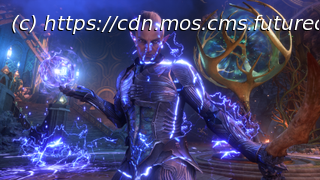Bloodless, perfunctory and broad.
When BioWare started working on Dragon Age: The Veilguard, the world was in love with Marvel. We wanted more Avengers, more bants, more Nick Fury recruiting super-powered heroes. This must have felt serendipitous to a studio which had, for years, been designing RPGs where players put together a wise-cracking, good-looking squad to stop the world—and sometimes galaxy—from imploding.
Dragon Age: The Veilguard is BioWare’s Avengers, fully leaning into the idea of a heroic team of powerhouses protecting everyone from the worst of the worst—between bouts of exposition and lots of banter, of course. But unfortunately it’s now 2024, the Marvel formula has become exhausting, and BioWare’s latest RPG—which I’m now around three quarters of the way through—feels both perfunctory and behind the curve.
Maybe we would have ended up here even without Marvel’s huge influence on modern entertainment. While the series began as an exceptionally grim fantasy adventure in a grounded medieval world, Dragon Age has never been comfortable sitting still. Dragon Age 2 preserved much of the tone, despite the switch to smaller stakes and a more focused setting, but Inquisition then put you in charge of a high fantasy version of SHIELD in a game full of absurd stakes and magic spectacle.
But it also still felt like a Dragon Age game. A different style of Dragon Age game, sure, but one that still featured nuanced characters who pushed and questioned you, set in a world that, for all its vibrant colours and flashy magic, still felt tragic and sorrowful. It served as an interesting counterpart to Origins, where you played a hero (or anti-hero) trying to thwart a tyrant. As the Inquisitor, there was always the sense that you might become that tyrant yourself. In The Veilguard, however, Dragon Age’s legacy is nearly invisible. Thedas’s questionable glow up
The Veilguard sheds most of the series’ nuance and darkness, fully committing to bloodless, broad high fantasy with a Marvel veneer—less Thesdas and more Asgard. It’s even got that gaudy Marvel colour palette, where everything glows and sears your retinas. It’s all just so over the top—constantly trying to show off and elbow you, forcing you to look at one ostentatious set piece after another.
This perseveres even when The Veilguard impotently attempts to showcase some horror. When you explore a Blight-infested village in an early section, the pulsating neon-red cysts and gratuitous use of tentacles is so cartoonish that it’s impossible to feel the revulsion that the story wants you to experience. The Blight is ultimately left to just become a momentary obstacle, blocking paths until you destroy a bunch of connected nodes. It’s just a mechanical nuisance that rears its head countless times throughout the game.
The Veilguard even takes Marvel’s sci-fi-tinged approach to fantasy. Bellara, your elven archer, swans around with a massive golden gauntlet that splices magic and tech, is a talented engineer, and is part of a mostly-elvish organisation which studies and preserves ancient, arcane technology. Even their name, the Veil Jumpers, feels like something drawn from a sci-fi comic. Where previous games presented the elves as a race brought down by human colonialism, pushed to the fringes and constantly struggling with racism and ostracisation, The Veilguard’s elves are primarily represented by an organisation of fancy magical scientists.
Magic, broadly, has a very different tone this time around. Some of this is down to the switch from southern Thedas to Tevinter and the surrounding areas, where mages have a lot more influence and aren’t kept on a tight leash, as they are in Ferelden. But the loss of tension between mages and Templars is felt keenly, and The Veilguard doesn’t give us anything to fill the gap. Instead, mages are just—like so much in this game—generically cool.
Narratively, there’s not much to them—they’re just another class, and most of the time the only distinction between a mage and a warrior is how they handle in combat, where the former fights like an amalgamation of Iron Man and Doctor Strange, with staffs that might as well be laser cannons and big glowing shields that surround their bodies like a force field. Whenever they pull off some spells, it turns the battlefield into a rave.
There’s just nothing here that feels connected to the grounded world BioWare originally built. One of the first things you see when you start the game is a flying Tevinter citadel, you have to participate in a jailbreak where the prison is under the sea, your HQ sits on a floating island inside the Veil and you’re literally fighting a pair of gods—something everyone largely takes in their stride.
Домой
United States
USA — software With The Veilguard, Dragon Age has forgotten its dark fantasy roots and...






